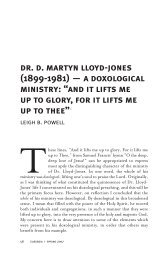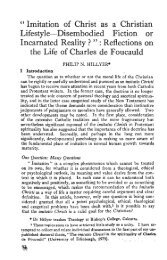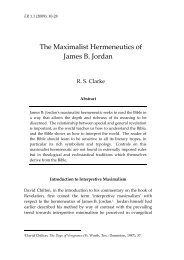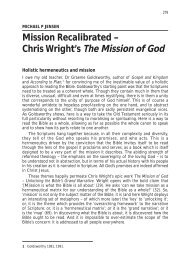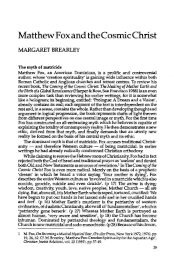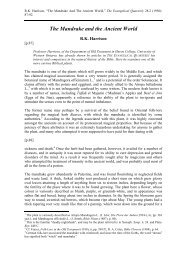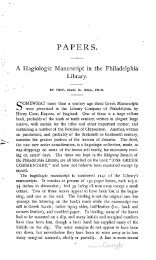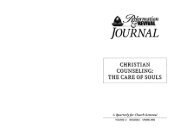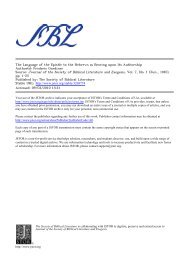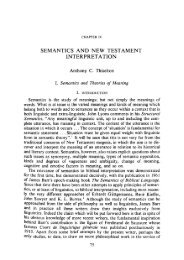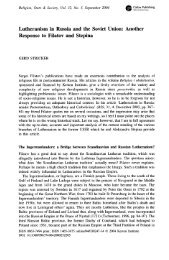Ancient Orient and Old Testament - BiblicalStudies.org.uk
Ancient Orient and Old Testament - BiblicalStudies.org.uk
Ancient Orient and Old Testament - BiblicalStudies.org.uk
Create successful ePaper yourself
Turn your PDF publications into a flip-book with our unique Google optimized e-Paper software.
K.A. Kitchen, <strong>Ancient</strong> <strong>Orient</strong> <strong>and</strong> <strong>Old</strong> <strong>Testament</strong>. London: Inter-Varsity Press, 1966. Hbk. pp.191.<br />
[p.41]<br />
Gilgamesh of Ur<strong>uk</strong>. 24 Thus, whatever one may make of the large figures in Genesis 5 <strong>and</strong> I I, the<br />
names themselves - on the closest <strong>Ancient</strong> <strong>Orient</strong>al analogy - are not necessarily to be considered as<br />
unhistorical merely because these figures are attached to them.<br />
(c) The Literary Structure of Early Genesis (1-9)<br />
This now finds early parallels. New evidence bearing on the Atrakhasis Epic shows that in<br />
Mesopotamia there also existed the literary schema: creation, development <strong>and</strong> degeneration of man,<br />
list of names before the Flood, then the Flood itself. 25 As various fragments indicate that the<br />
Atrakhasis Epic certainly goes back as far as the <strong>Old</strong> Babylonian period, 26 this literary pattern had its<br />
floruit at least as early as Abraham, an interesting point in regard to the antiquity of this form of the<br />
tradition. This is also true of the Sumerian King List, composed not later than the Third Dynasty of<br />
Ur, c. 2000 Ba, <strong>and</strong> embodying the antediluvian tradition in its final form, c. 1800 BC. 27<br />
II. THE DATE OF THE PATRIARCHAL AGE 28<br />
As Noth has recently pointed out, 29 scholars are not all agreed upon the date of the Patriarchal Age.<br />
Does Abraham belong<br />
[p.42]<br />
24 Cf. Gadd, op. cit., pp. 19-22; Rowton, loc. cit.; <strong>and</strong> W. G. Lambert in P. Garelli (ed.), Gilgameš et sa Ligende,<br />
1960, pp. 39-56, esp. 46-52. Note that in the Tummal building-chronicle, Gilgamesh is included on the same<br />
level as, <strong>and</strong> in the midst of, such historically attested kings as Enmebaragisi, Mesannepadda, etc. ;<br />
translation, cf. Kramer, The Sumerians, 1963, pp. 48-49, 47. Kingship in Gn. 6:1-4, cf. Kline, WTJ 24 (1962),<br />
187-204.<br />
25 See W. G. Lambert, JSS 5 (1960), pp. 113-123, esp. 115-116; for the reconstructed cuneiform text of<br />
Atrakhasis, cf. W. G. Lambert <strong>and</strong> A. R. Millard, Cuneiform Texts... (British Museum), XLVI, 1965. See also references<br />
in A. L. Oppenheim, <strong>Ancient</strong> Mesopotamia, 1964) p. 372, n. 45.<br />
26 Lambert, JSS 5 (1960), p. 114 <strong>and</strong> references.<br />
27 See p. 38, above, <strong>and</strong> references in note 13.<br />
28 The literature on the Patriarchs grows constantly; only a selection can be cited here. Best over-all survey is<br />
(in French) R. de Vaux, RB 53 (1946) PP- 321 - 348; RB 55 (1948) pp. 321 - 347; RB 56 (1949), pp. 5-36 (in<br />
book-form collected in German as R. de Vaux, Die hebräischen Patriarchen <strong>and</strong> die modernen Entdeckungen,<br />
1961), supplemented by de Vaux in RB 72(1965), pp. 5-28 (as German booklet, Die Patriarchenerzählungen<br />
<strong>and</strong> die Geschichte, 1965). Elementary books include C. F. Pfeiffer, The Patriarchal Age, 1961 (good<br />
outline, but bibliography is too generalized) <strong>and</strong> J. M. Holt, The Patriarchs of Israel, 1964 (readable, but<br />
diffuse, too often neglects primary data in favour of secondary sources, <strong>and</strong> is partly obsolete, e.g. ignores<br />
Vergote, Joseph en Égypte, 1959). For Abraham, see D. J. Wiseman, The Word of God for Abraham <strong>and</strong><br />
Today, 1959, <strong>and</strong> A. Parrot, Abraham et son temps, 1962. Recent studies of varying value include H.<br />
Cazelles, ‘Patriarches’ in H. Cazelles <strong>and</strong> A. Feuillet (eds.), Supplément au Dictionnaire de la Bible, VII/<br />
Fasc. 36, 1961, cols. 81-156 (valuable survey, good bibliography to 1959); W. F. Albright, BASOR 163<br />
(1961), pp. 36-54 (valuable material); <strong>and</strong> three papers by J. C. L. Gibson, JSS 7 (1962), pp. 44-62, S.<br />
Yeivin, RSO 38 (1963) pp. 277-302, <strong>and</strong> F. Vattioni, Augustinianum 4 (1964), pp. 331-357 all with useful<br />
points but unsatisfactory in various details. Very inadequate is O. Eissfeldt, CAH 2 , II:26a (Palestine in the<br />
Nineteenth Dynasty: Exodus <strong>and</strong> W<strong>and</strong>erings), 1965, pp. 5-16; cf. my review-article, THB 17 (1966), pp.<br />
63-97, on the nature <strong>and</strong> possible historicity of the Patriarchs. 29 VTS, VII, 1960, pp. 265-271.<br />
29 VTS, VII, 1960, pp. 265-271.




